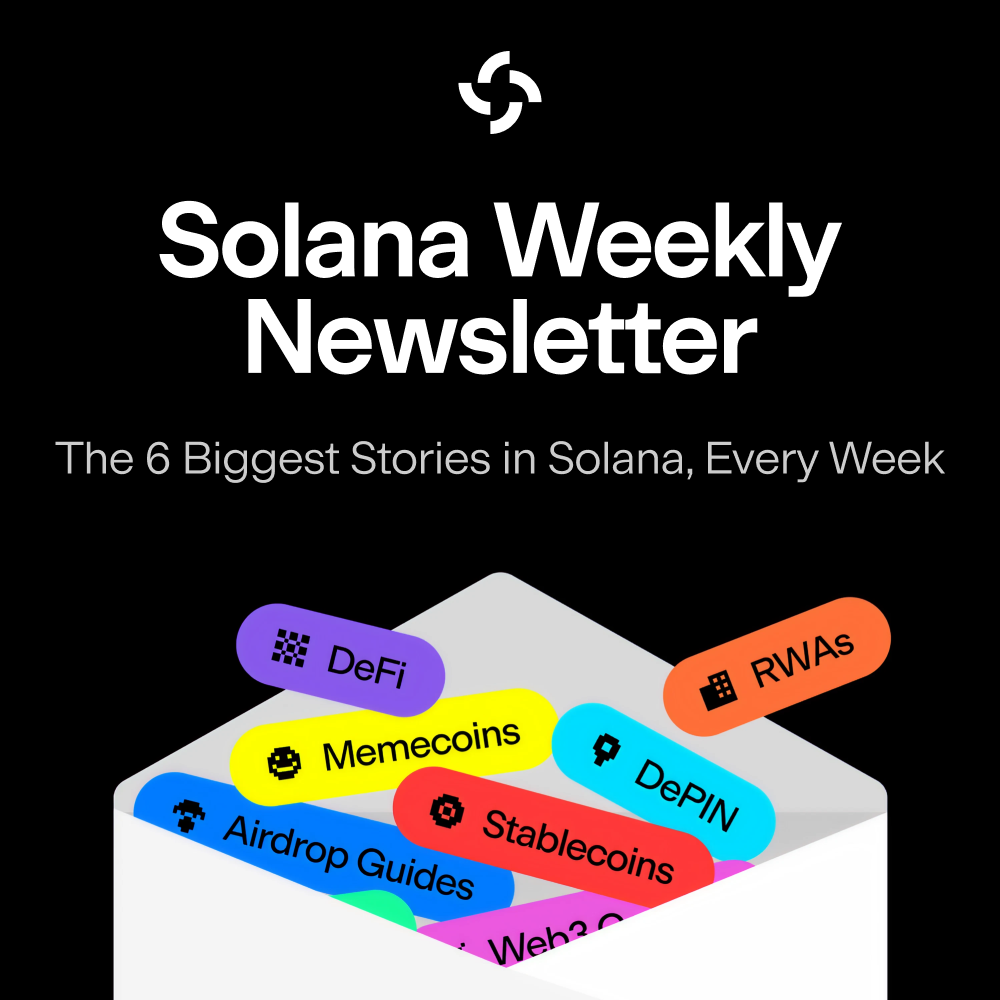
Explosive Interest in Solana DATs Overshadowed by Systemic Risks
Digital Asset Treasuries could expedite this cycle’s blow-off top and consequent death spiral
- Published:
- Edited:
Inspired by the success of Michael Saylor’s Strategy playbook, TradFi investors are spinning up Digital Asset Treasuries (DATs) with impunity, pumping zombie stocks and crypto prices across markets.
Newly emerging DATs are met with rampant enthusiasm. Frontmen like Michael Saylor and Tom Lee are celebrated as the prophets of future gains to come. TradFi investors have wasted no time writing 9-10 figure checks to power $SOL accumulation strategies and kickstart up-only flywheels.
What people seem to either forget, or choose to ignore, is that flywheels are not self-sustaining. Without external forces pushing continuous motion, the sails start luffing. Only when the tide goes out will we see who’s swimming naked.
Do DATs pose a systemic risk to Solana? What does an unraveling DAT look like, and which company presents the most risk?
The Violent Delights and Violent Ends of the DAT Flywheel
DATs have captivated the imagination and attention of crypto markets. While each DAT is a heavily nuanced investment vehicle, crypto treasury companies typically leverage the same economic flywheel.
-
Company raises millions to accumulate $SOL
-
Company accumulates $SOL
-
Company’s aggressive accumulation of $SOL drives prices higher
-
$SOL price appreciation boosts Company’s NAV
-
Company’s valuation increases in relation to growing NAV
-
Company raises more funds against its growing valuation
-
Repeat
DATs typically rely on their stock trading at a premium to their NAV, creating a positive mNAV, which represents the company’s value in relation to its crypto holdings. If a DAT’s mNAV = 2, that means that the market has priced the company at 2x the value of its held $SOL. When mNAV is higher than 1, the company can raise funds through various methods of stock issuance to buy more $SOL.
At first glance, the DAT looks like a thinly-veiled, leveraged long on $SOL. By taking on debt or issuing new stock and diluting investors, DATs can continually fund ongoing $SOL accumulation and generate yield through staking rewards.
Everyone from Solana Labs co-founder Raj Gokal to memecoin flippers has come out in support of the ‘capital formation flywheel’ employed by Solana DATs. However, news that locked, discounted $SOL is now being traded to emerging DATs has raised fresh questions about their longevity and impact on the market.
Before diving into the more dubious accusations, let’s briefly outline the various outlooks on Solana DATs.
The Bull Case
Advocates in favor of Solana DATs posit that $SOL is uniquely positioned as the best possible underlying asset for crypto treasury companies. Generating between 6-8% APY via staking rewards, $SOL’s yield-generation makes it a more attractive option than Bitcoin.
Solana is undoubtedly one of crypto’s most compelling assets. The network boasts more users than any other blockchain by several orders of magnitude, and is the most popular platform for founders and developers to build new applications.
Digital Asset Treasuries with a long-term outlook are unfazed by mNAV volatility. Having an mNAV > 1 favors equity issuance and enables DATs to raise more funds; when mNAV drops below 1, DATs are able to use raised funds to scoop cheap $SOL and increase their SOL-per Share.
Solana Defi enables DATs to further leverage their assets to drive accumulation. For example, DATs who’ve issued LSTs, like Defi Development Corporation, can actively borrow against their staked $SOL to buy more $SOL.
$SOL price directly appreciates as more DATs telegraph future $SOL accumulation plans. Anytime a treasury announces a mouth-watering raise, $SOL holders can reasonably expect to believe that the company will continually buy $SOL and support the asset’s appreciation.
Is it all too good to be true?
The Bear Case
As much as the DAT flywheel turbo-charges $SOL’s ascendance, the reflexive feedback loop also works in the opposite direction. While some might argue that falling mNAV allows DATs to accumulate more $SOL at lower prices and increase their $SOL-per-Share, negative price swings can have a dangerous impact on DAT health.
Falling $SOL prices will effectively erode a DAT’s NAV, dropping its mNAV to levels where companies may struggle to raise ongoing capital. Depending on the manner in which companies have raised funds, some DATs may succumb to forced selling to meet debt obligation requirements.
At press time, 1-3 Bitcoin treasury companies currently trade at a sub-1 mNAV, while Blockworks data suggests that the aggregate mNAV across all $ETH DATs has also fallen below 1.
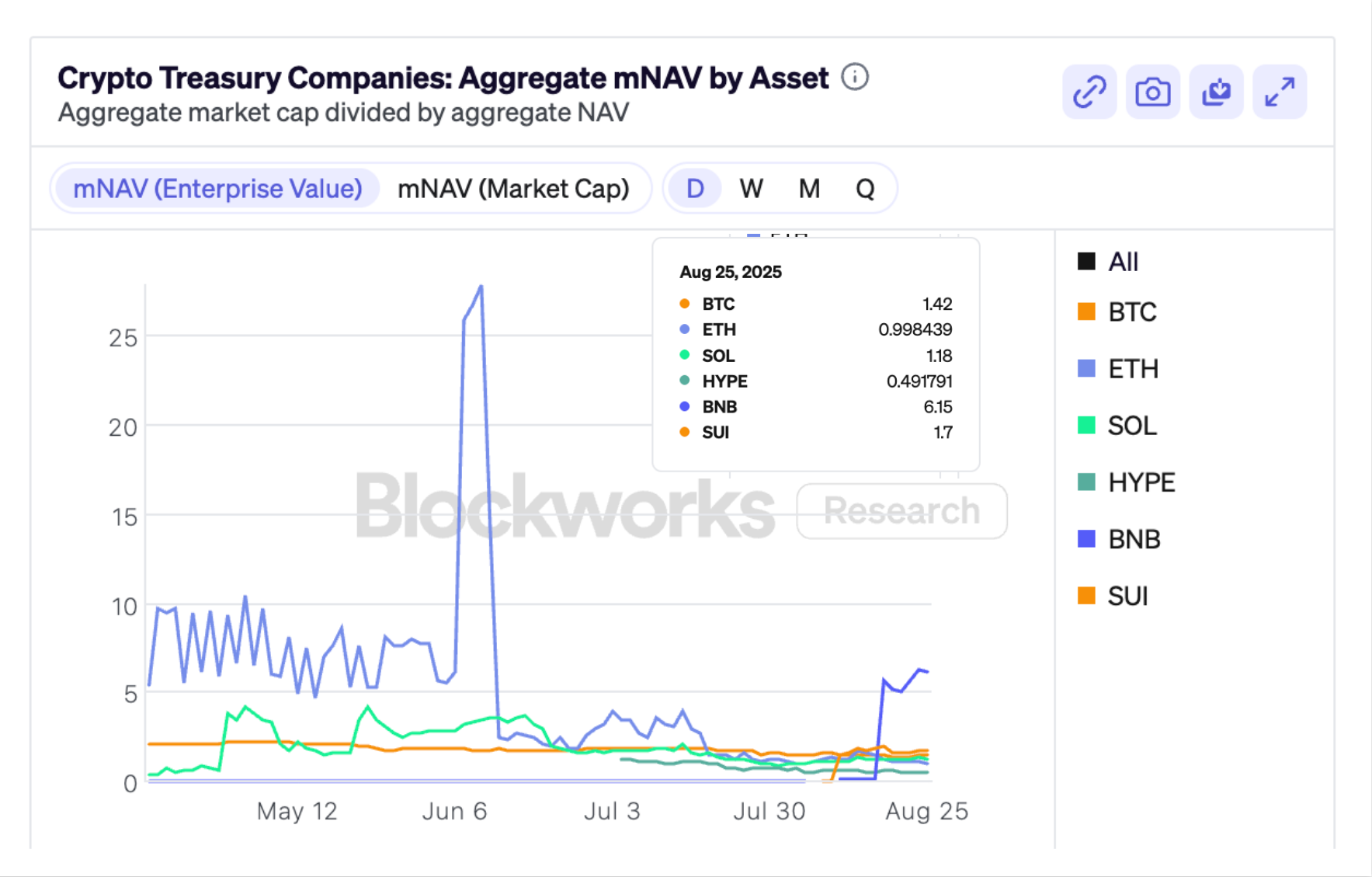
Ethereum-based DAT Sharplink recently announced the launch of a stock repurchase program, demonstrating that some DATs will opt to buyback shares to support the value of its common stock. The firm has stated that buybacks will be more value-accretive when the share price trades below its NAV. However, this becomes a slippery slope towards liquidating assets to defend stock price, especially in the case of firms that have opted for debt-based fundraising.
While it’s unlikely that DATs would sell their holdings to defend a crumbling stock price, embattled companies may become an easy target for activist investors and zealous shareholders.
Perhaps emboldened by the impact of Tom Lee’s serial $ETH bullposting, the Solana Foundation has stepped into the ring to find Solana’s TradFi champion. The non-profit organization has reportedly signed a Letter of Intent with Sharps Technology to sell $50M worth of locked $SOL at a 15% discount to the asset’s 30D time-weighted average price.
The Foundation’s involvement in the DAT arms race is widely considered a bullish prospect for $SOL price moving forward, but some commentators argue this development reeks of foul play. Avi Felman argues that the transmission of locked $SOL to treasury vehicles is a roundabout way of enabling funds like Pantera to “dump on retail”.
By exchanging locked $SOL for equity placements and exposure to $SOL-via-DAT, funds can realize profits and exit their positions by selling common stock on public markets.
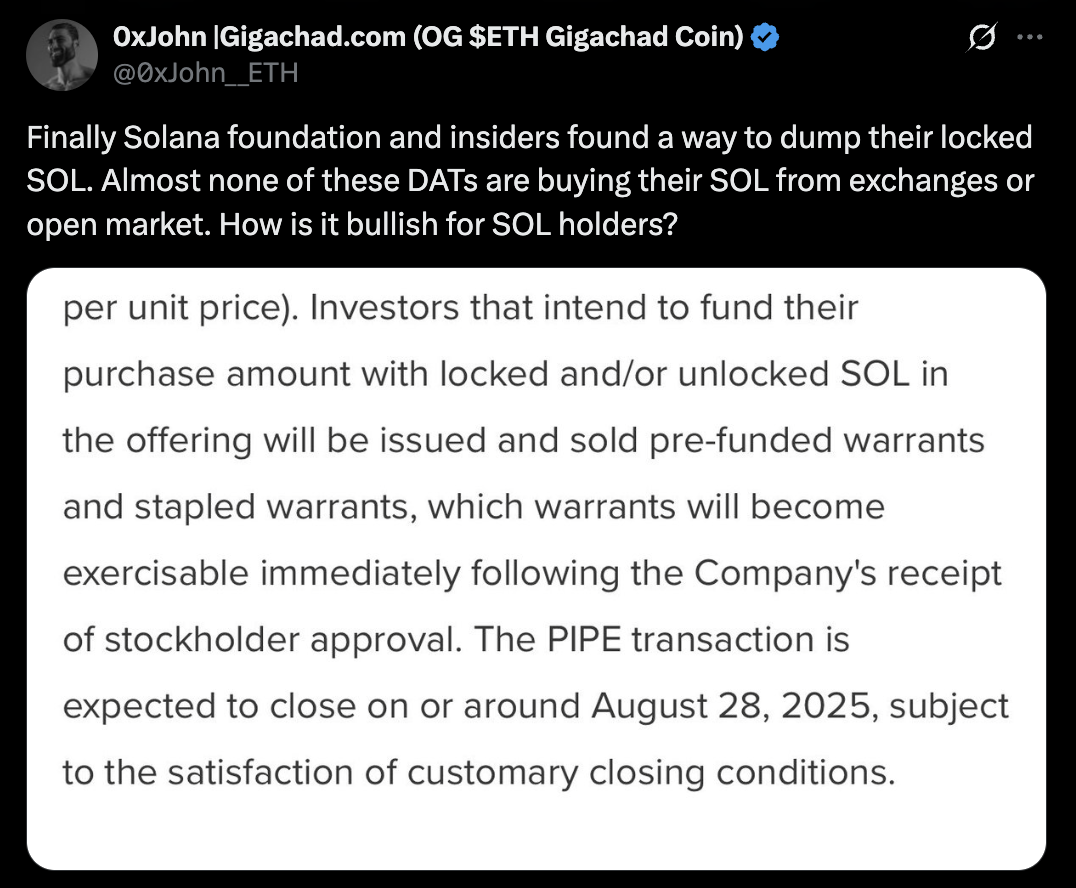
Others have denounced the sale of locked $SOL, saying it gives investors and large holders an expedited exit strategy and will have no impact on $SOL market dynamics. On August 25, Bloomberg reported that Galaxy, Multicoin, and Jump Crypto were all engaged in a $1B raise to form a new Foundation-endorsed Solana DAT.
This seems at odds with a report published in late July by Galaxy Digital researcher Will Owens, who states that the abundance of the DAT model made the flywheel “structurally fragile”. Others have predicted that the DAT phenomenon could trigger an unwind event reminiscent of the 2022’s GBTC collapse.
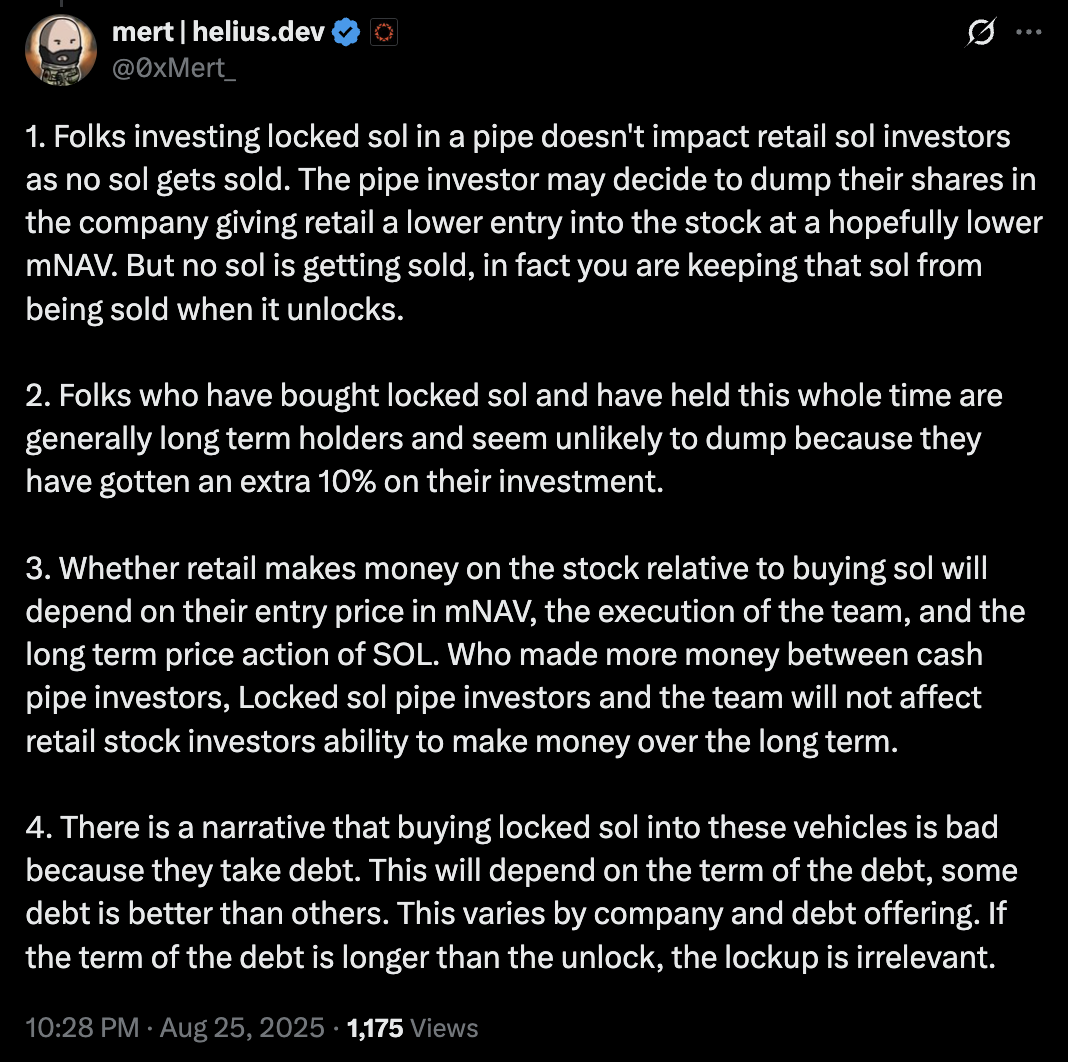
Helius co-founder Mert Mumtaz downplayed the perceived malice associated with the sale of locked $SOL. Responding to concerned 𝕏 commentators, Mumtaz opined that no $SOL was getting sold, and that funds buying locked $SOL are typically long-term holders seeking more than a 10% return on their investment.
Before gathering torches and pitchforks, it’s worth noting that the Solana Foundation’s involvement in DAT formation pales in comparison to the positioning of its rivals in the Ethereum Foundation. EF sold 10,000 $ETH to Sharplink in an OTC deal in July 2025, largely due to its close connection to Sharplink Chairman Joseph Lubin, a listed Ethereum co-founder and current CEO of R&D firm Consensys.
The Risk Profiles of Solana DATs
Solana’s DATs have leveraged various strategies to raise billions in supposedly idle capital just waiting to deploy in crypto markets.
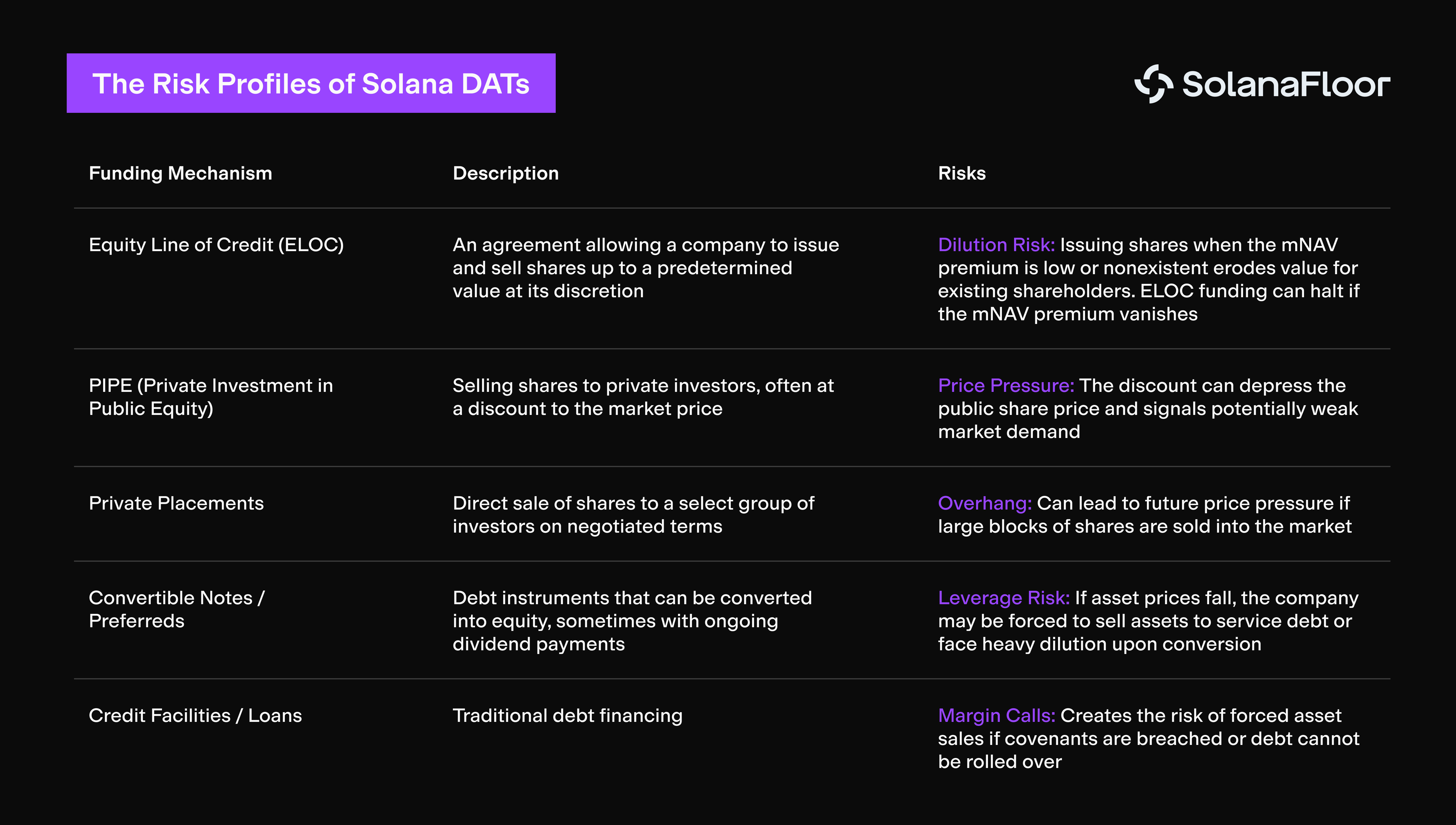
Solana DATs taking debt-based positions, such as credit facilities like those opened by Sol Strategies in January 2025, present a systemic risk. In the event that $SOL slips below Sol Strategies' liquidation price, the holding company may be forced to sell its holding to meet debt obligations.
Other Solana-based treasuries that have demonstrated a willingness to take on higher levels of risk include Classover Holdings and market leader Upexi. Classover’s $500 million credit facility consists of senior secured convertible notes. These notes are secured by a "first priority perfected security interest in all of the existing and future assets of the Company," which explicitly includes the cryptocurrency purchased with the proceeds. In a default, lenders could seize and liquidate the company's SOL treasury.
That leads us to Upexi. Boasting over 200M $SOL, Solana’s largest DAT has taken advantage of various funding strategies, including PIPE raises and $150M secured convertible note is collateralized by spot and locked $SOL, which could poses a liquidation threat and could be seized by lenders in a market downturn.
What Does an Unwinding DAT Look Like?
Leverage is a dangerous game at any level of sophistication. For all their experience and knowledge, DAT operators aren’t that different from perps degens looking to make it all back in one trade.
Courtesy of the announcement of multiple 9-10 figure fundraises to purchase $SOL, DATs have been accepted by the crypto community with open arms. However, the proliferation of this investment model and the ‘capital formation flywheel’ they perpetuate pose a systemic risk that cannot be overlooked.
Debt-based DATs pose the greatest threat to existing $SOL holders. If $SOL price action brings crypto treasury companies down to liquidation levels, the forced selling of millions of dollars worth of assets could result in a vicious death spiral. This would bring the more resilient DATs into dangerous territory, with dramatically discounted mNAVs.
Underwater treasury companies will find themselves devoid of willing LPs and investors. Loss-averse shareholders could then pressure DATs into liquidating their holdings to preserve capital, leading to further market depreciation.
The lingering question remains: does the crypto market even care? Financial markets are unforgiving by nature, but crypto’s cultural zeitgeist has glorified terms like “no crying in the casino”.
Some of crypto’s staunchest supporters have relished the fact that the emergence of DATs is nothing more than an ironic ponzi by which TradFi provides timely exit liquidity for crypto natives. Why should we care if shareholders get diluted if it pumps our bags, or if an LP commits funds in exchange for common stock that loses value?
Play stupid games, win stupid prizes. Why question a flawed system when you can benefit from it?
In the eyes of big-money players, Crypto DATs are the degenerate cousin of the less glamorous crypto ETF, and undoubtedly the most exciting thing to happen this cycle. The high-stakes flywheel is an elaborate cover for a billion-dollar game of musical chairs, which may catalyse this round’s blow-off top and the onset of the next crypto winter.
Read More on SolanaFloor
TradFi sets sights on Solana BTC-Fi
Zeus Network to Power NASDAQ-Listed Metalpha’s Search for Bitcoin Yield on Solana
Does Solana Have a Perception Problem?

